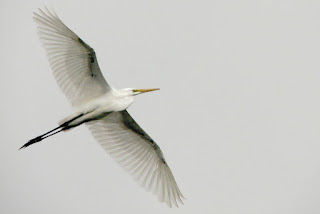The Backward Step
Tibetan teacher Chögyam
Trungpa once opened a class by drawing a V on a large white sheet of
poster paper. He then asked those present what he had drawn. Most responded
that it was a bird. “No,” he told them. “It’s the sky with a bird flying
through it.”
How we pay attention
determines our experience. When we’re in doing or controlling mode, our
attention narrows and we perceive objects in the foreground—the bird, a
thought, a strong feeling. In these moments we don’t perceive the sky—the
background of experience, the ocean of awareness. The good news is that through
practice, we can intentionally incline our minds toward not controlling and
toward an open attention.
My formal introduction to
what is often called “open awareness” was through dzogchen—a Tibetan Buddhist
practice. Until then, I’d trained in concentration and mindfulness, always
focusing on an object (or changing objects) of attention. In dzogchen, as
taught by my teacher Tsoknyi Rinpoche, we repeatedly let go of whatever our
attention fixates on and turn toward the awareness that is attending. The
invitation is to recognize the skylike quality of the mind—the empty, open,
wakefulness of awareness—and be that.
My first retreat with
Tsoknyi Rinpoche loosened my moorings in a wonderful way. The more I became
familiar with the presence of awareness, the weaker the foothold was for the
feelings and stories that sustained my sense of self. Tensions in my body and
mind untangled themselves, and my heart responded tenderly to whoever or
whatever came to mind. I left that retreat, and later dzogchen retreats,
feeling quite spacious and free.
I more recently learned of
the work of Les Fehmi, a psychologist and researcher who for decades has been
clinically documenting the profound healing that arises from resting in open
awareness. In the 1960s researchers began to correlate synchronous alpha brain
waves with profound states of well-being, peace, and happiness.
Fehmi, an early and
groundbreaking leader in this research, sought strategies that might deepen and
amplify alpha waves. Experimenting with student volunteers, he tracked their
EEG readings as they visualized peaceful landscapes, listened to music, watched
colored lights, or inhaled various scents. But it was only after he posed the
question, “Can you imagine the space between your eyes?” that their alpha wave
levels truly soared. (NOTE: here is a link to a downloadable guided meditation
that I've adapted from Fehmi's work, titled, "Inner Space: Gateway to Open
Awareness" - http://www.tarabrach.com/audioarchives-guided-meditations.html.)
He posed another: “Can you
imagine the space between your ears?” The subjects’ alpha waves spiked again.
Further experimentation confirmed the effects of what Fehmi termed “open
focused attention.” The key was inviting attention to space (or stillness or
silence or timelessness) and shifting to a nonobjective focus.
Narrowly focused attention
affects our entire body-mind. Whenever we fixate on making plans, on our next
meal, on judgments, on a looming deadline, our narrowed focus produces faster
(beta) waves in the brain. Our muscles tense, and the stress hormones cortisol
and adrenaline are released. While necessary for certain tasks, as
an ongoing state this stress constellation keeps us from full health,
openheartedness, and mental clarity.
In contrast, open-focused
attention rests the brain. With a sustained pause from processing
information—from memories, plans, thoughts about self—brain waves slow down
into synchronous alpha. Our muscles relax, stress hormone levels are lowered,
blood flow is redistributed. No longer in fight-or-flight reactivity, our body
and mind become wakeful, sensitive, open, and at ease.
You may have noticed the effect
of open awareness when looking at the night sky and sensing its immensity. Or
during the silence in the early morning before sunrise. Or when the world is
still after a snowfall. We resonate with such moments because they connect us
with the most intimate sense of what we are. We sense the depth of our being in
the night sky, the mystery of what we are in the silence, the stillness. In
these moments of objectless awareness there’s a wordless homecoming, a
realization of pure being.
In practicing open awareness,
I’ve found it helpful to think of existence—the entire play of sounds and
thoughts and bodies and trees—as the foreground of life, and awareness as the
background. In the Zen tradition, the shift from focusing on the foreground of
experience to resting in pure being is called “the backward step.”
Whenever we step out of thought or emotional reactivity and remember the
presence that’s here, we’re taking the backward step.
If we wake up out of a
confining story of who we are and reconnect with our essential awareness, we’re
taking the backward step. When our attention shifts from a narrow fixation on
any object—sound, sensation, thought—and recognizes the awake space that holds everything,
we’re taking the backward step. We come to this realization when there is
nowhere else to step. No anything. We’ve relaxed back into the immensity
and silence of awareness itself.
You might pause for a moment
and receive this living world. Let your senses be awake and wide open, taking
everything in evenly, allowing life to be just as it is. As you notice the
changing sounds and sensations, also notice the undercurrent of awareness—be
conscious of your own presence.
Allow the experience of life
to continue to unfold in the foreground as you sense this alert inner stillness
in the background. Then simply be this space of awareness, this
wakeful openness. Can you sense how the experiences of this world continues to
play through you, without in any way capturing or confining the inherent
spaciousness of awareness? You are the sky with the bird flying through; you
are, as a traditional Tibetan saying teaches:
Utterly awake, senses wide
open.
Utterly open, nonfixating
awareness.
Adapted from True Refuge (2013)
Enjoy this talk on Wise Investigation
For more information visit: www.tarabrach.com



